Nighthawk117
On this page, you find all documents, package deals, and flashcards offered by seller nighthawk117.
- 343
- 0
- 33
Community
- Followers
- Following
376 items
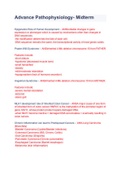
Nurs 6501 Advance Pathophysiology- Midterm with verified accurate solutions available
Epigenetics Role of Human Development - ANSheritable changes in gene expression or phenotype which is caused by mechanisms other than changes in DNA sequences. -the modification determines the fate of each cell. -DNA sequence remains the same, the transcriptional activity of most genes varies. Prader-Willi Syndrome - ANSInherited 4-Mb deletion chromosome 15 from FATHER. Features include: -short stature -hypotonia (decreased muscle tone) -small hands/feet -obesity -mild-moderate re...
- Package deal
- Exam (elaborations)
- • 6 pages •
Epigenetics Role of Human Development - ANSheritable changes in gene expression or phenotype which is caused by mechanisms other than changes in DNA sequences. -the modification determines the fate of each cell. -DNA sequence remains the same, the transcriptional activity of most genes varies. Prader-Willi Syndrome - ANSInherited 4-Mb deletion chromosome 15 from FATHER. Features include: -short stature -hypotonia (decreased muscle tone) -small hands/feet -obesity -mild-moderate re...
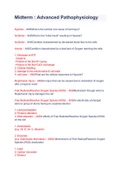
Nurs 6501 Midterm : Advanced Pathophysiology with verified solutions available
Hypoxia - ANSWhat is the number one cause of Cell Injury? Ischemia - ANSWhat is the "initial insult" resulting in Hypoxia? Ischemia - ANSCondition characterized by decreased blood flow to the cells Anoxia - ANSCondition characterized by a total lack of Oxygen reaching the cells 1. Decrease of ATP -Leads to: +Failure of the Na+/K+ pump +Failure of the Na+/Ca2+ exchanger 2. Cellular Swelling 3. damage to the mitochondria & cell walls 4. cell lyses - ANSWhat are the cell...
- Package deal
- Exam (elaborations)
- • 20 pages •
Hypoxia - ANSWhat is the number one cause of Cell Injury? Ischemia - ANSWhat is the "initial insult" resulting in Hypoxia? Ischemia - ANSCondition characterized by decreased blood flow to the cells Anoxia - ANSCondition characterized by a total lack of Oxygen reaching the cells 1. Decrease of ATP -Leads to: +Failure of the Na+/K+ pump +Failure of the Na+/Ca2+ exchanger 2. Cellular Swelling 3. damage to the mitochondria & cell walls 4. cell lyses - ANSWhat are the cell...
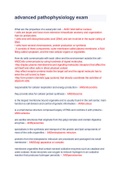
Nurs 6501 advanced pathophysiology exam with grade A+ and with verified solutions available
What are the properties of a eukaryotic cell - ANS• Well define nucleus. • cells are larger and have more extensive intracellular anatomy and organization than do prokaryotes. • cells bind with deoxyribonucleic acid (DNA) and are involved in the super coiling of DNA. • cells have several chromosomes, protein production or synthesis . it consists of three components: outer membrane called plasma membrane, a fluid filling called cytoplasm, and the intra cellular organs or organelles...
- Package deal
- Exam (elaborations)
- • 13 pages •
What are the properties of a eukaryotic cell - ANS• Well define nucleus. • cells are larger and have more extensive intracellular anatomy and organization than do prokaryotes. • cells bind with deoxyribonucleic acid (DNA) and are involved in the super coiling of DNA. • cells have several chromosomes, protein production or synthesis . it consists of three components: outer membrane called plasma membrane, a fluid filling called cytoplasm, and the intra cellular organs or organelles...
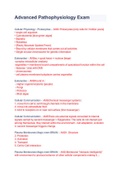
Nurs 6501 Advanced Pathophysiology Exam with grade A+ and with accurate answers
Cellular Physiology - Prokaryotes - ANS• Prokaryotes [only cells for 3 billion years] • single cell organism • Cyanobacteria [blue-green algae] • Bacteria • Rickettsia • [Rocky Mountain Spotted Fever] • Bound by cellular membrane that carries out all activities • Single circular chromosome for genetic information Eukaryotes - ANSeu = good karyo = nucleus [large) -complex intracellular anatomy -organelles = membrane bound compartments of specialized function within t...
- Package deal
- Exam (elaborations)
- • 48 pages •
Cellular Physiology - Prokaryotes - ANS• Prokaryotes [only cells for 3 billion years] • single cell organism • Cyanobacteria [blue-green algae] • Bacteria • Rickettsia • [Rocky Mountain Spotted Fever] • Bound by cellular membrane that carries out all activities • Single circular chromosome for genetic information Eukaryotes - ANSeu = good karyo = nucleus [large) -complex intracellular anatomy -organelles = membrane bound compartments of specialized function within t...
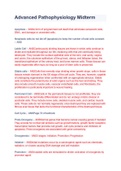
Nurs 6501 Advanced Pathophysiology Exam and Midterm Pack Bundle
Nurs 6501 Advanced Pathophysiology Exam and Midterm Pack Bundle with Accurate Solutions available
- Package deal
- • 10 items •
- Nurs 6501 Advanced Pathophysiology - Exam (Neuro) with verified accurate answers available • Exam (elaborations)
- Nurs 6501 Advanced Pathophysiology Exam with grade A+ and with accurate answers • Exam (elaborations)
- Nurs 6501 Advanced Pathophysiology Exam with grade A+ and with accurate solutions available • Exam (elaborations)
- Nurs 6501 advanced pathophysiology exam with grade A+ and with verified solutions available • Exam (elaborations)
- Nurs 6501 Midterm : Advanced Pathophysiology with verified solutions available • Exam (elaborations)
- And more ….
Nurs 6501 Advanced Pathophysiology Exam and Midterm Pack Bundle with Accurate Solutions available
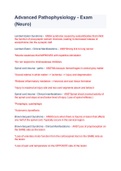
Nurs 6501 Advanced Pathophysiology - Exam (Neuro) with verified accurate answers available
Lambert-Eaton Syndrome - ANSA syndrome caused by autoantibodies that inhibit the function of presynaptic calcium channels, leading to decreased release of acetylcholine into the synaptic cleft Lambert-Eaton - Clinical Manifestations - ANS*Strong link to lung cancer *Muscle weakness that IMPROVES with repetitive stimulation *Do not respond to cholinesterase inhibitors Spinal cord trauma - patho - ANS*Microscopic hemorrhages in central grey matter *Axonal edema in white matter --...
- Package deal
- Exam (elaborations)
- • 15 pages •
Lambert-Eaton Syndrome - ANSA syndrome caused by autoantibodies that inhibit the function of presynaptic calcium channels, leading to decreased release of acetylcholine into the synaptic cleft Lambert-Eaton - Clinical Manifestations - ANS*Strong link to lung cancer *Muscle weakness that IMPROVES with repetitive stimulation *Do not respond to cholinesterase inhibitors Spinal cord trauma - patho - ANS*Microscopic hemorrhages in central grey matter *Axonal edema in white matter --...

Nurs 6501 Advanced Pathophysiology Midterm with accurate solutions available
Apoptosis - ANSA form of programmed cell death that eliminates senescent cells, DNA,, and damage or unwanted cells. Neoplastic cells do not die off (apoptosis) to keep the number of total cells constant. - ANS Labile Cell - ANSContinuously dividing tissues are those in which cells continue to divide and replicate throughout our life, replacing cells that are continually being destroyed. They include the surface epithelial cells of the skin, oral cavity, vagina, and cervix; the columnar ...
- Package deal
- Exam (elaborations)
- • 10 pages •
Apoptosis - ANSA form of programmed cell death that eliminates senescent cells, DNA,, and damage or unwanted cells. Neoplastic cells do not die off (apoptosis) to keep the number of total cells constant. - ANS Labile Cell - ANSContinuously dividing tissues are those in which cells continue to divide and replicate throughout our life, replacing cells that are continually being destroyed. They include the surface epithelial cells of the skin, oral cavity, vagina, and cervix; the columnar ...
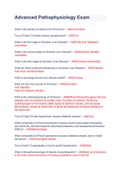
Nurs 6501 Advanced Pathophysiology Exam with verified solutions available and graded A+
What is the primary functional unit of the liver? - ANSLiver lobule True or False? Cirrhosis causes hypoglycemia? - ANSTrue What is the first stage of Alcoholic Liver Disease? - ANSFatty liver "Steatosis" (reversible) What is the second stage of Alcoholic Liver Disease? - ANSAlcoholic hepatitis (reversible) What is the third stage of Alcoholic Liver Disease? - ANSCirrhosis (Irreversible) What are three nutritional deficiencies in Alcoholic Liver Disease? - ANSThiamine, Fol...
- Package deal
- Exam (elaborations)
- • 17 pages •
What is the primary functional unit of the liver? - ANSLiver lobule True or False? Cirrhosis causes hypoglycemia? - ANSTrue What is the first stage of Alcoholic Liver Disease? - ANSFatty liver "Steatosis" (reversible) What is the second stage of Alcoholic Liver Disease? - ANSAlcoholic hepatitis (reversible) What is the third stage of Alcoholic Liver Disease? - ANSCirrhosis (Irreversible) What are three nutritional deficiencies in Alcoholic Liver Disease? - ANSThiamine, Fol...
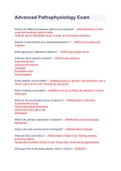
Nurs 6501 Advanced Pathophysiology Exam with grade A+ and verified solutions available
What is the difference between delirium and dementia? - ANS-Dementia is a slow onset that eventually leads to death. -Delirium has an identifiable cause, is rapid, and fluctuating symptoms Delirium is best defined as a change/disturbance in? - ANSConsciousness and Cognition What age group is effected by delirium? - ANSAll age groups can be What are the 6 cognitive domains? - ANSComplex attention Executive function Learning and memory Language Perceptual-motor Social cognition ...
- Package deal
- Exam (elaborations)
- • 17 pages •
What is the difference between delirium and dementia? - ANS-Dementia is a slow onset that eventually leads to death. -Delirium has an identifiable cause, is rapid, and fluctuating symptoms Delirium is best defined as a change/disturbance in? - ANSConsciousness and Cognition What age group is effected by delirium? - ANSAll age groups can be What are the 6 cognitive domains? - ANSComplex attention Executive function Learning and memory Language Perceptual-motor Social cognition ...
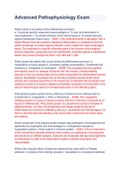
Nurs 6501 Advanced Pathophysiology Exam with grade A+ and verified accurate solutions available
Which action is a purpose of the inflammatory process? a. To provide specific responses toward antigens b. To lyse cell membranes of microorganisms c. To prevent infection of the injured tissue d. To create immunity against subsequent tissue injury - ANSC. If the epithelial barrier is damaged, then a highly efficient local and systemic response (inflammation) is mobilized to limit the extent of damage, to protect against infection, and to initiate the repair of damaged tissue. The response to ...
- Package deal
- Exam (elaborations)
- • 21 pages •
Which action is a purpose of the inflammatory process? a. To provide specific responses toward antigens b. To lyse cell membranes of microorganisms c. To prevent infection of the injured tissue d. To create immunity against subsequent tissue injury - ANSC. If the epithelial barrier is damaged, then a highly efficient local and systemic response (inflammation) is mobilized to limit the extent of damage, to protect against infection, and to initiate the repair of damaged tissue. The response to ...
